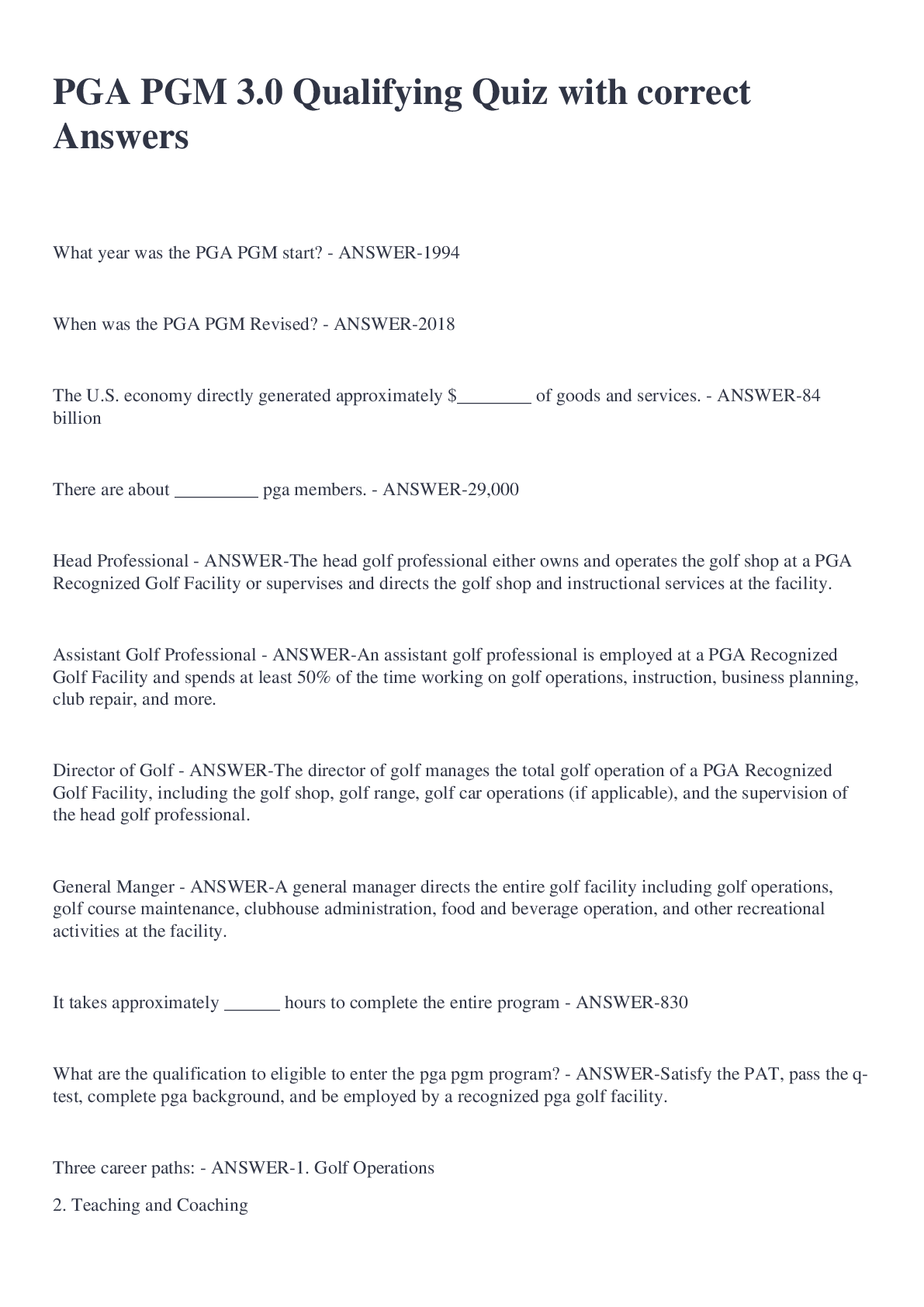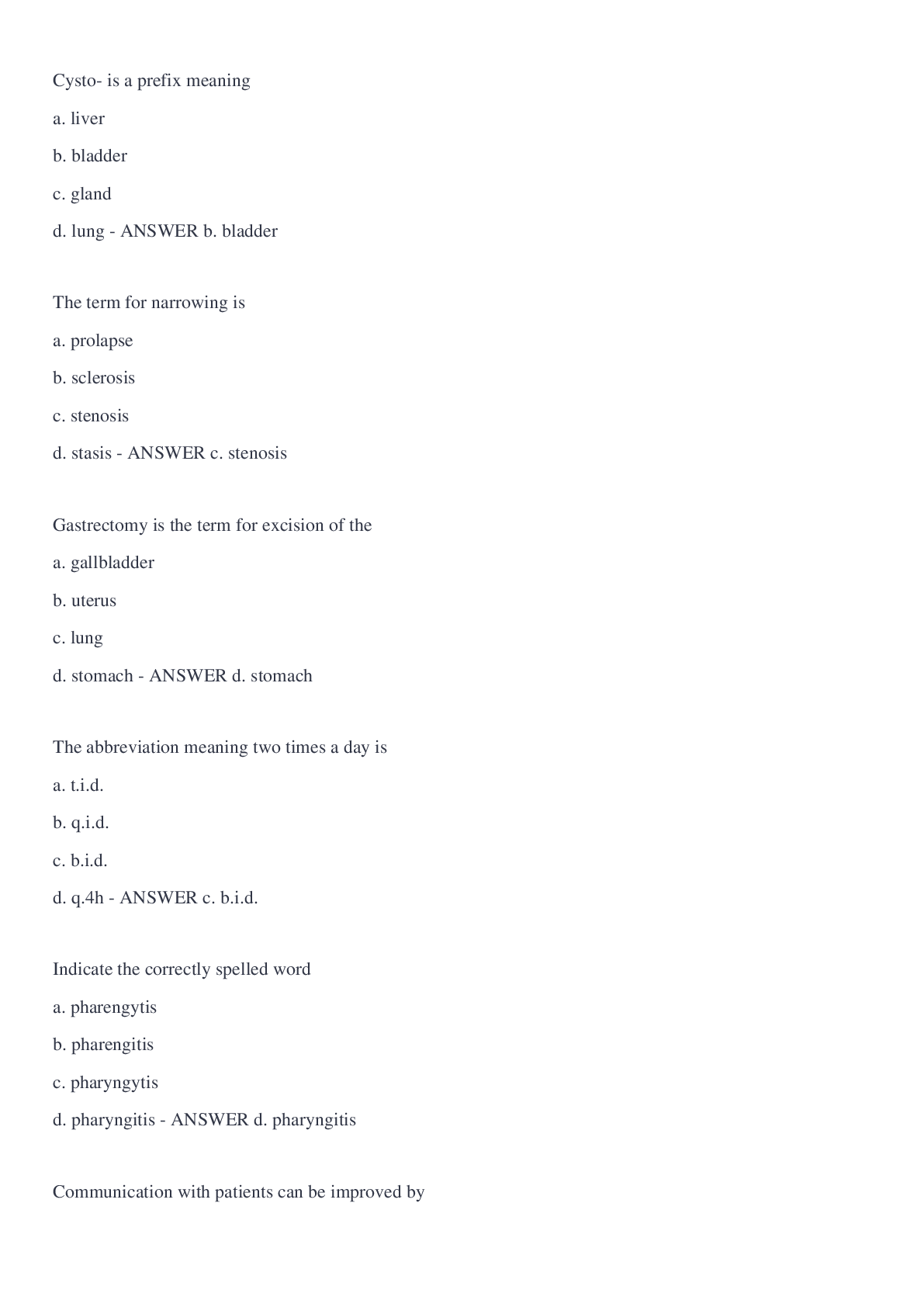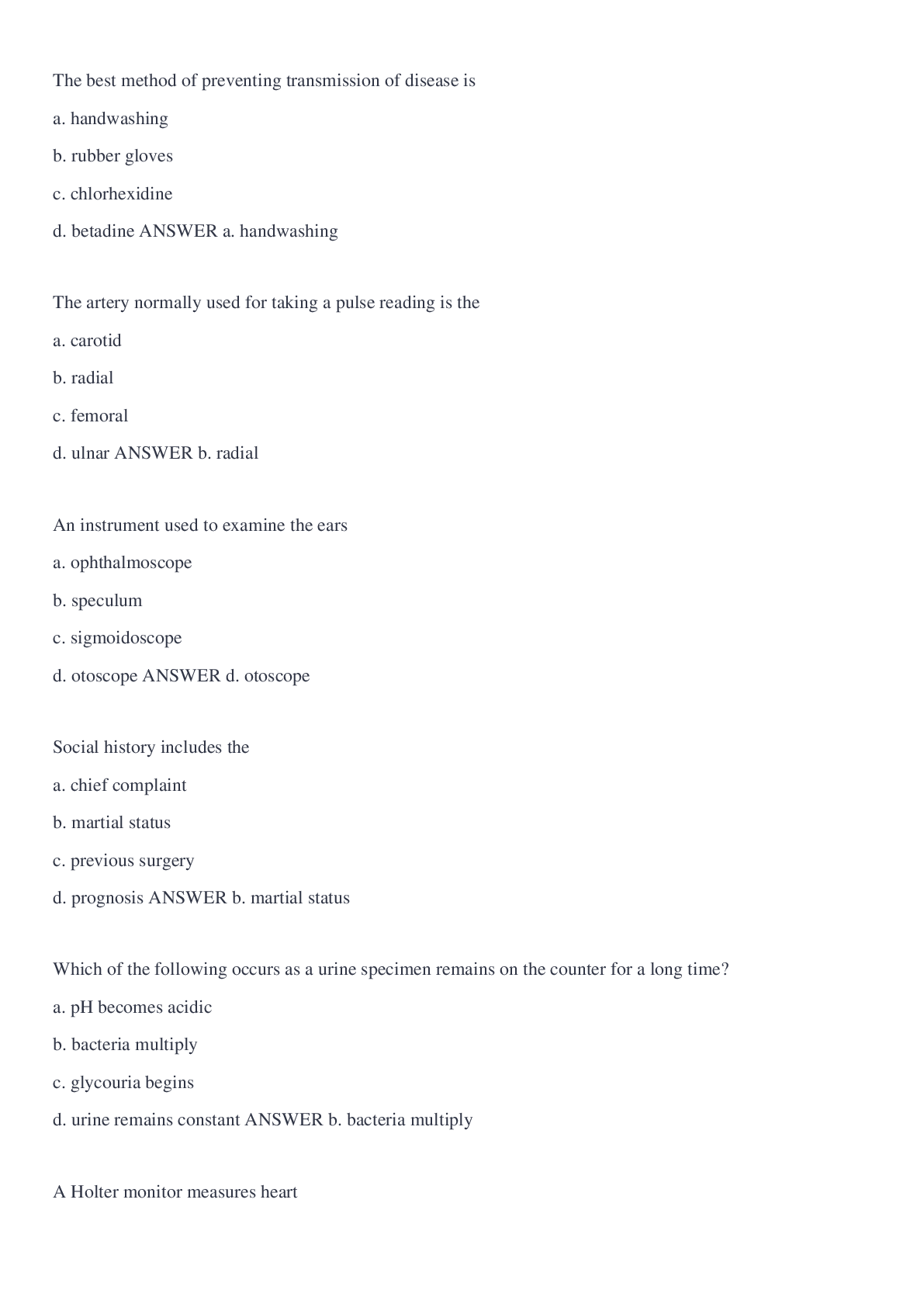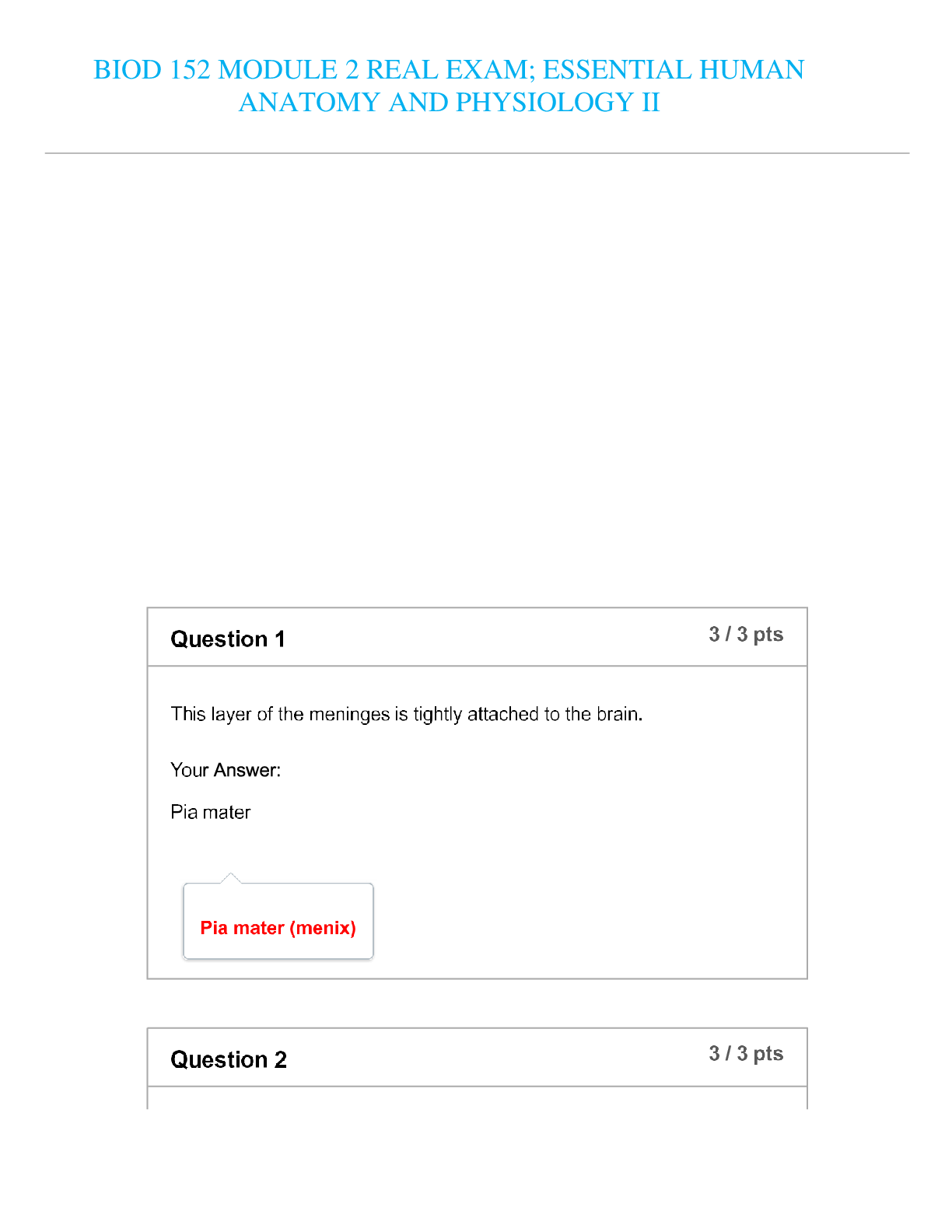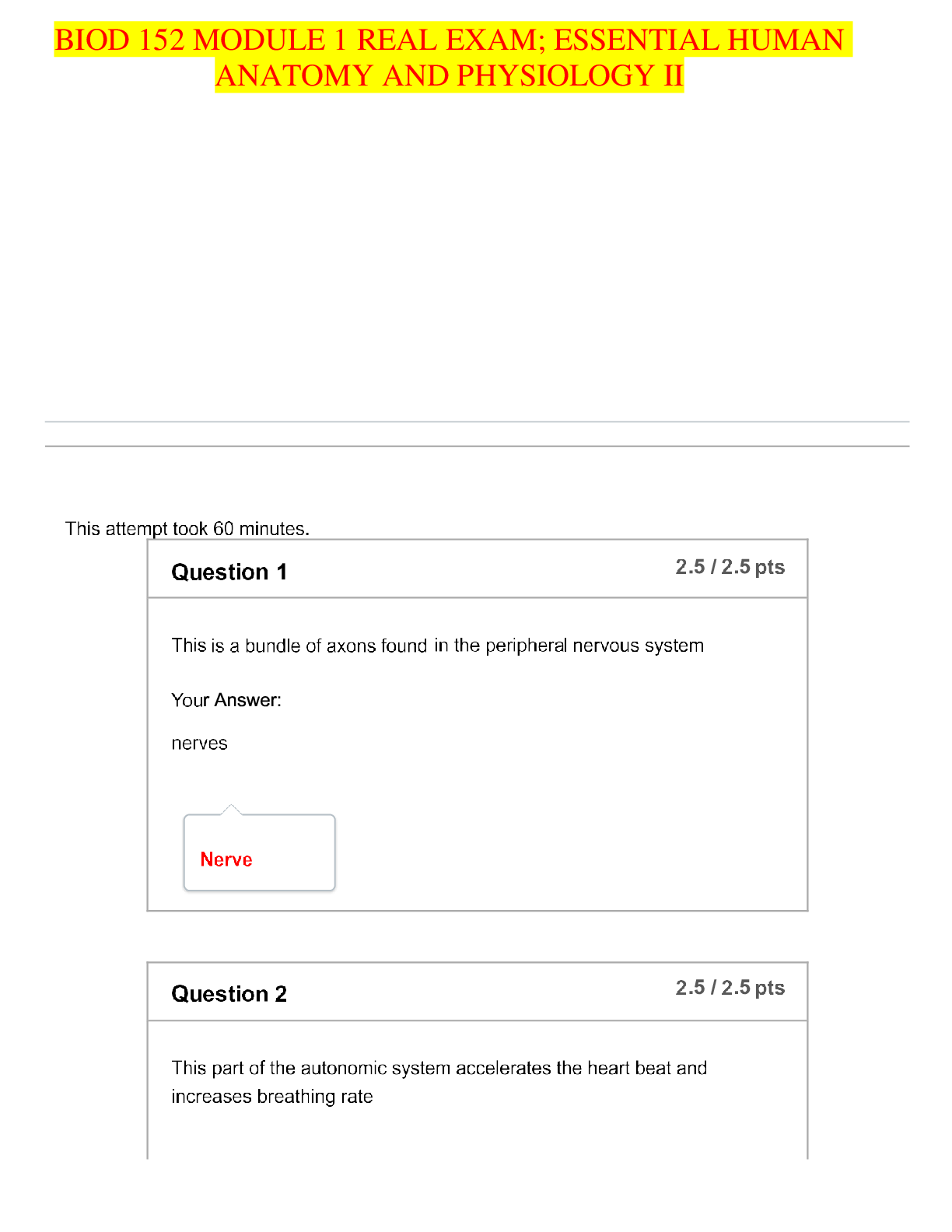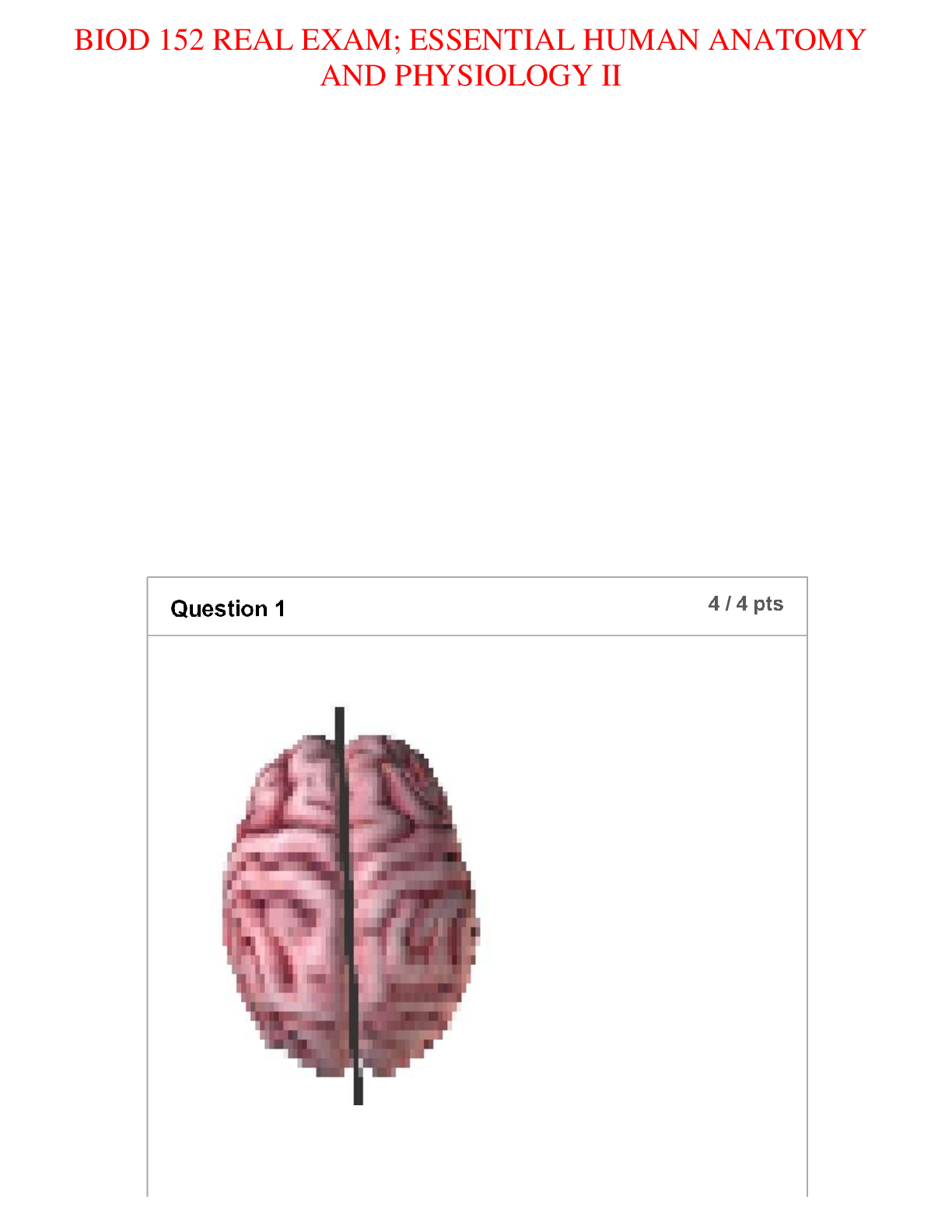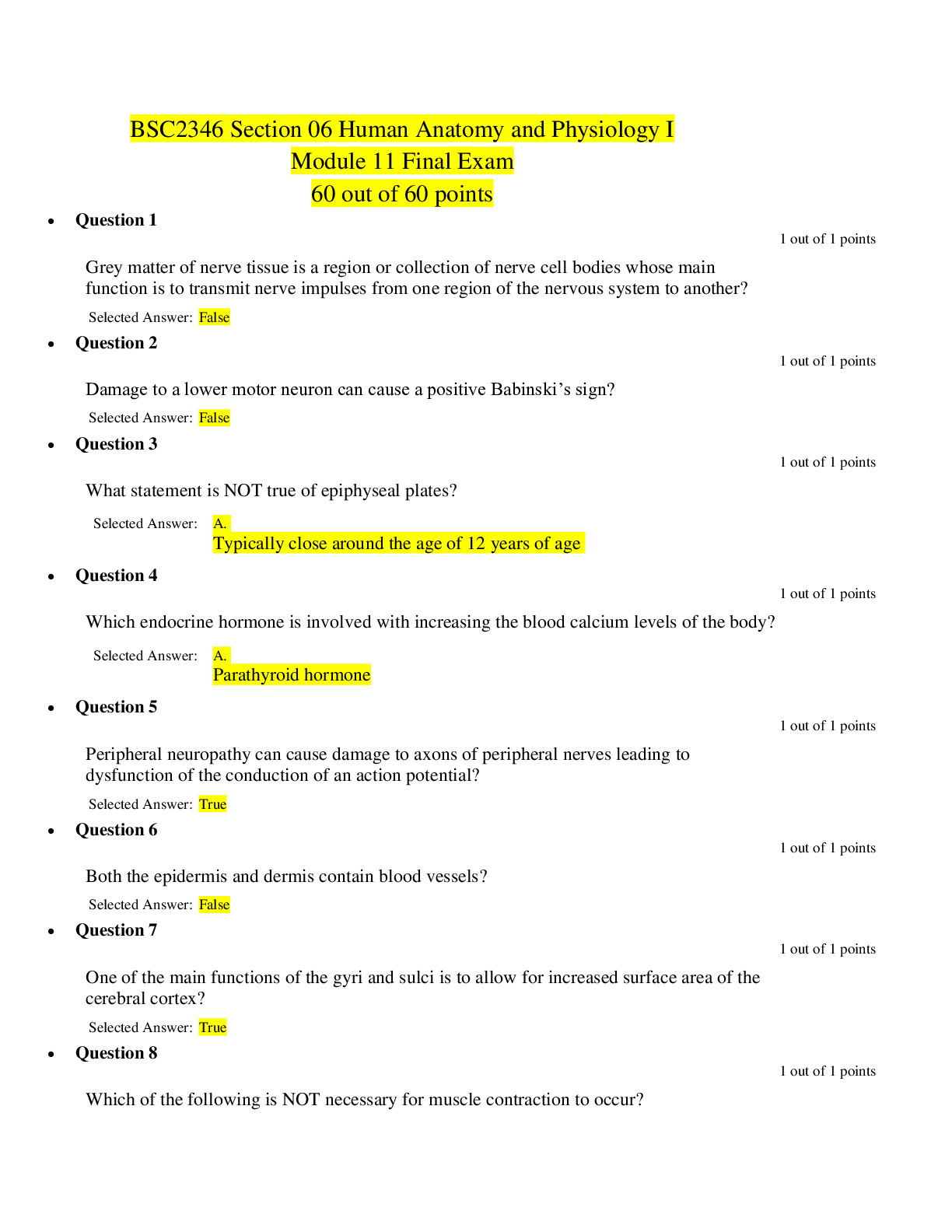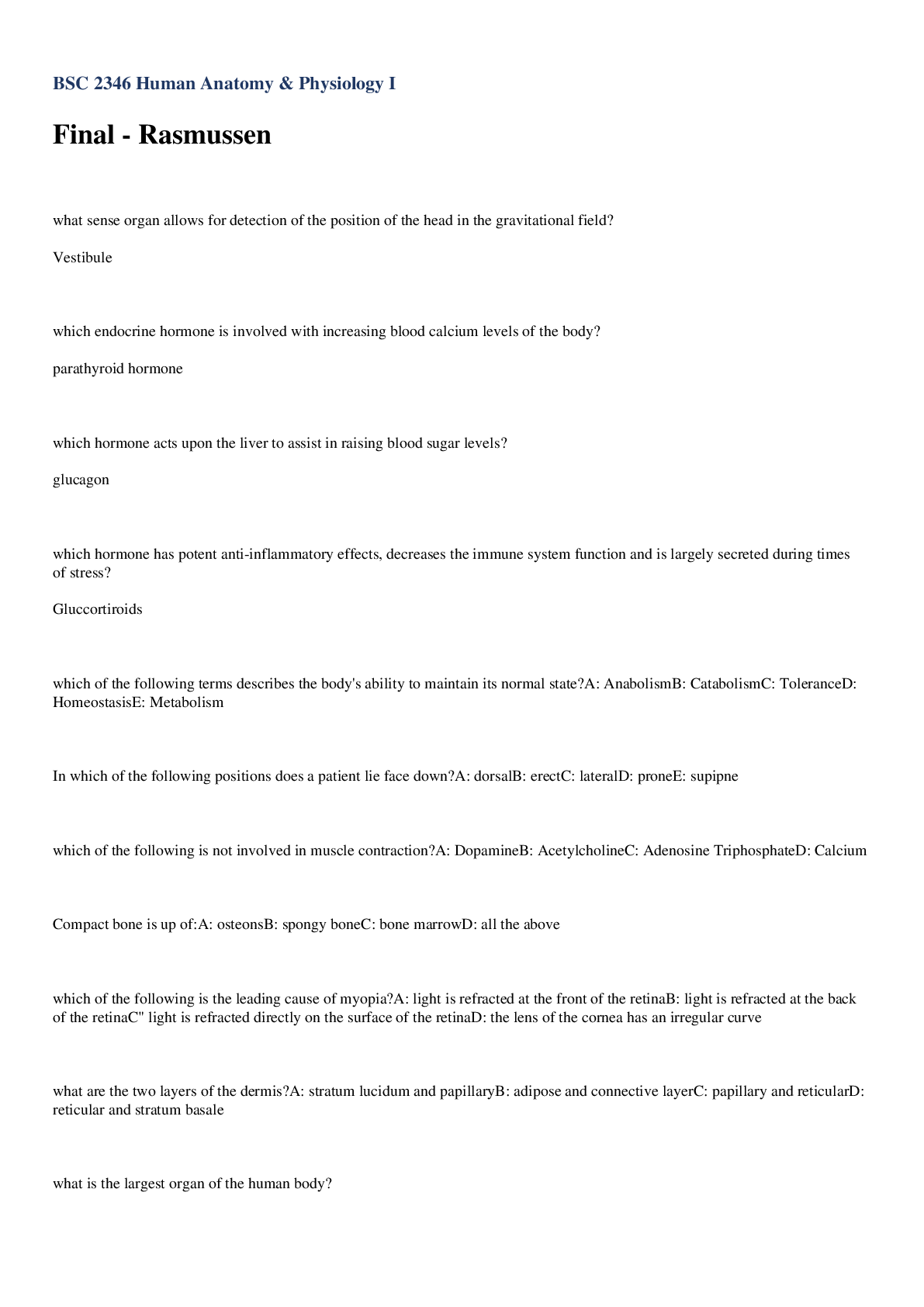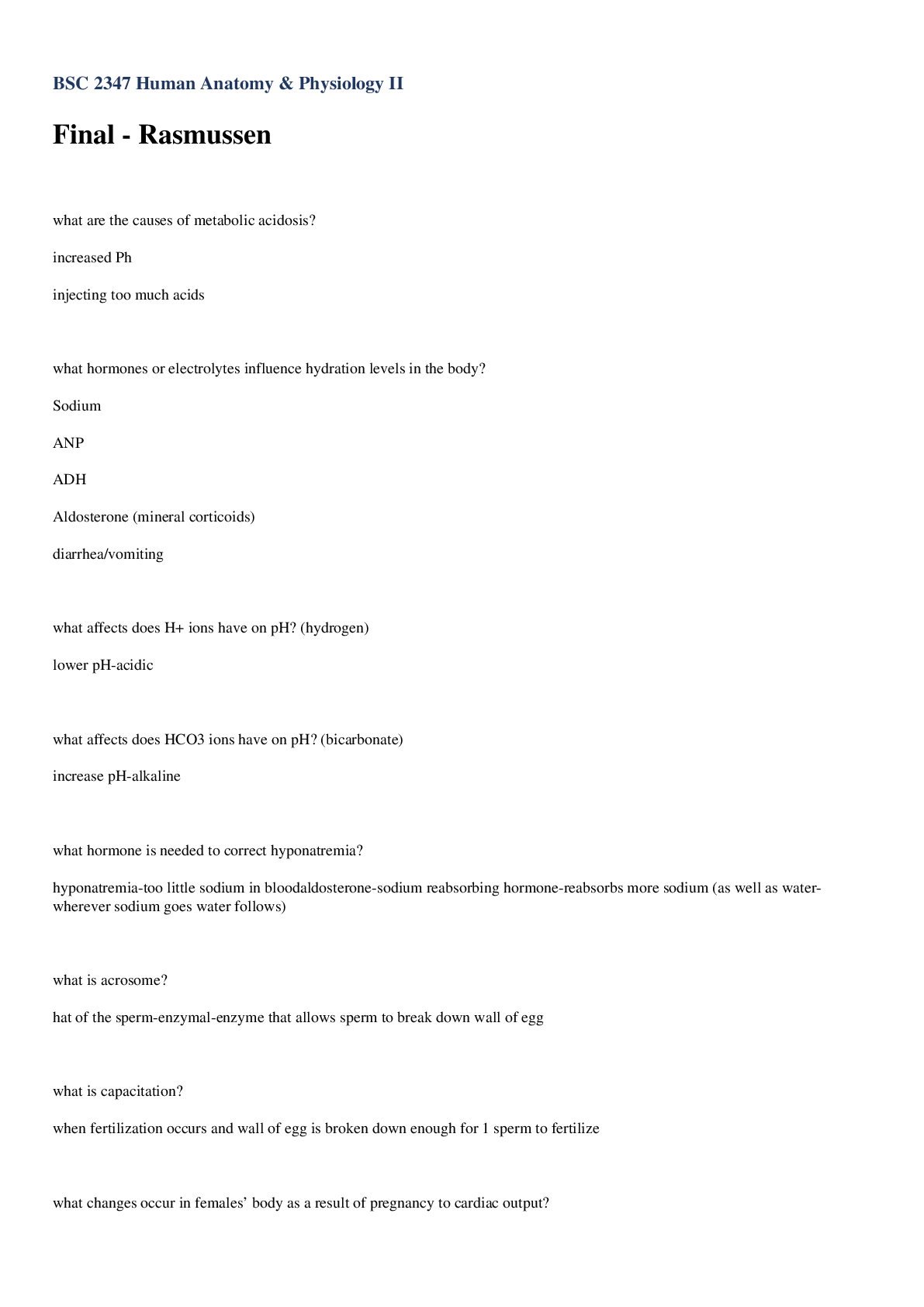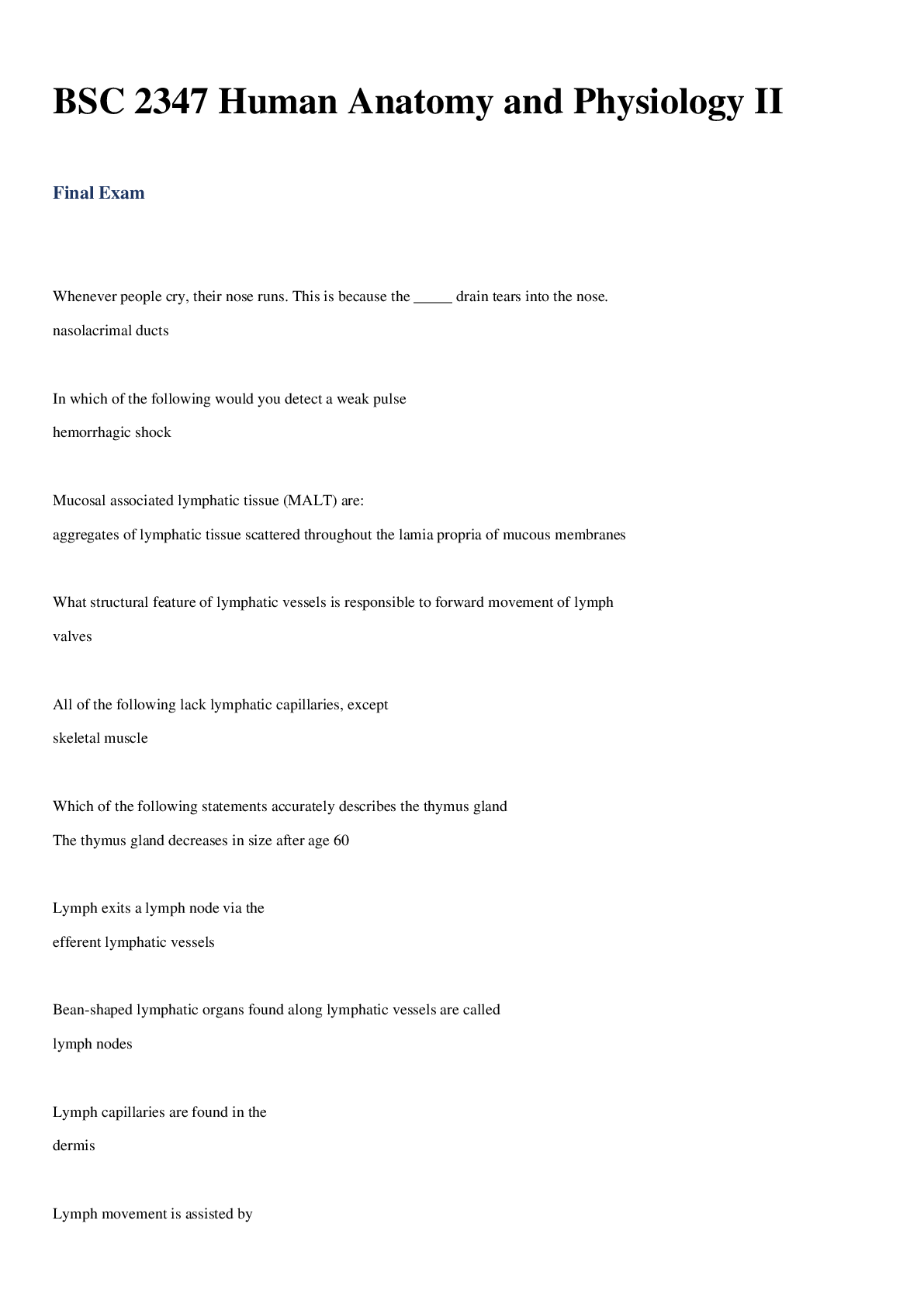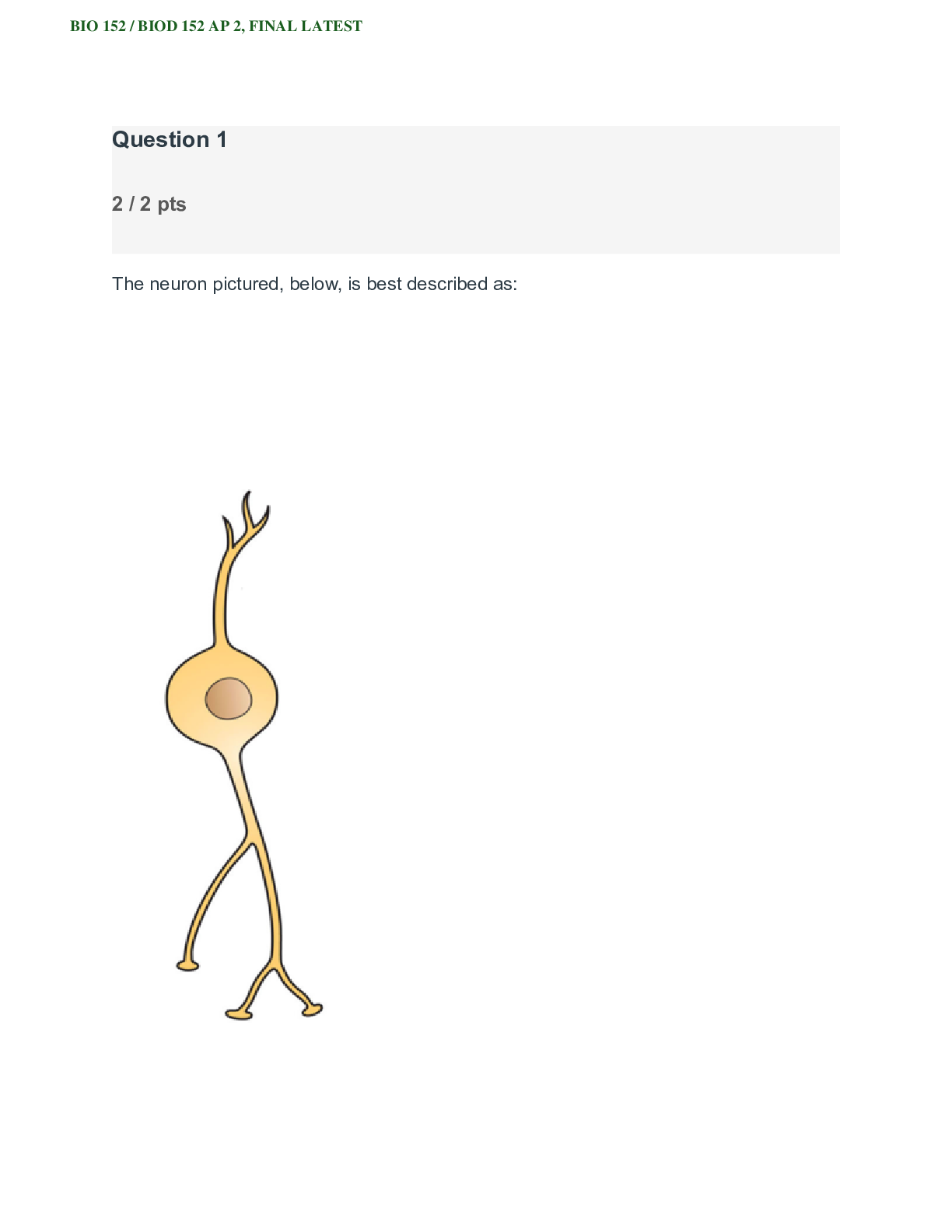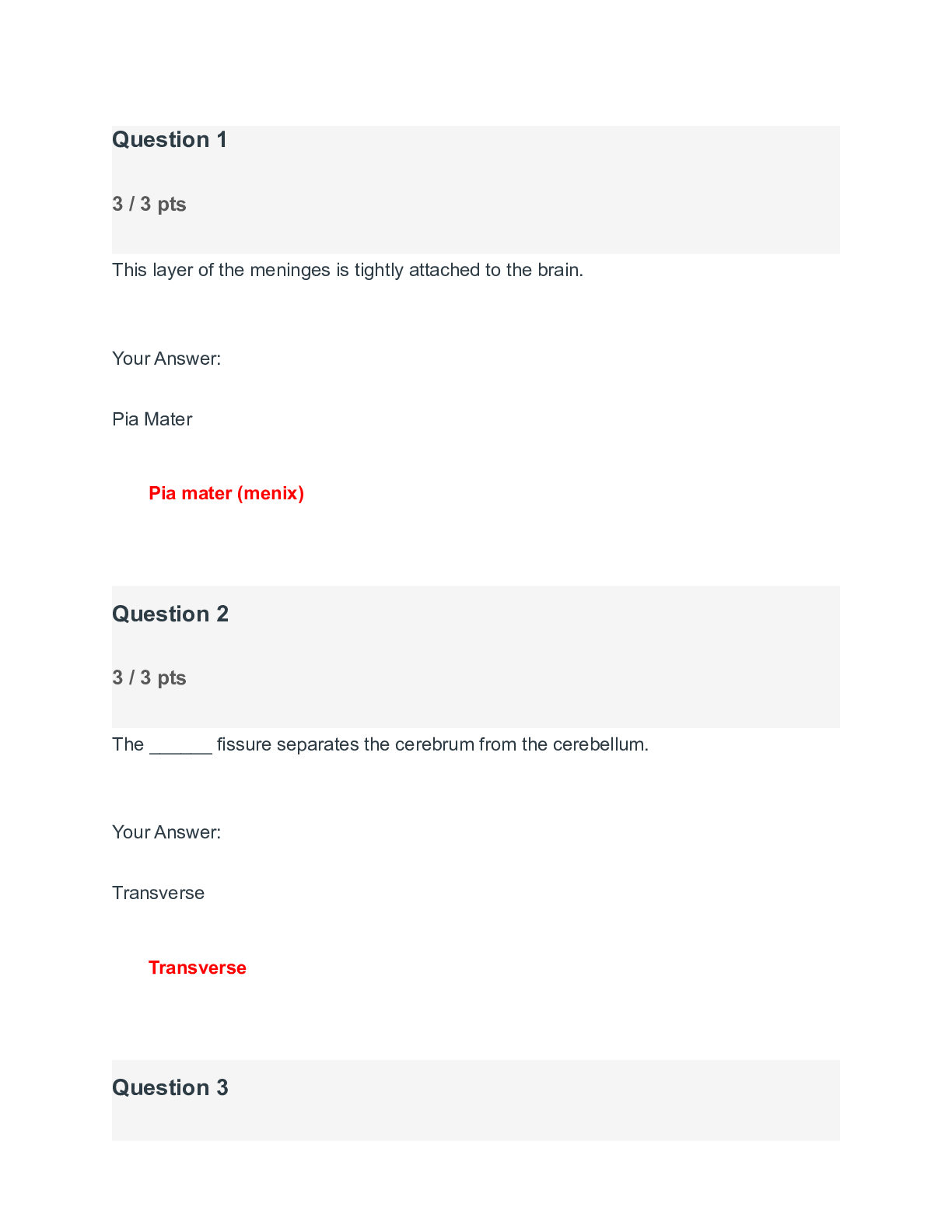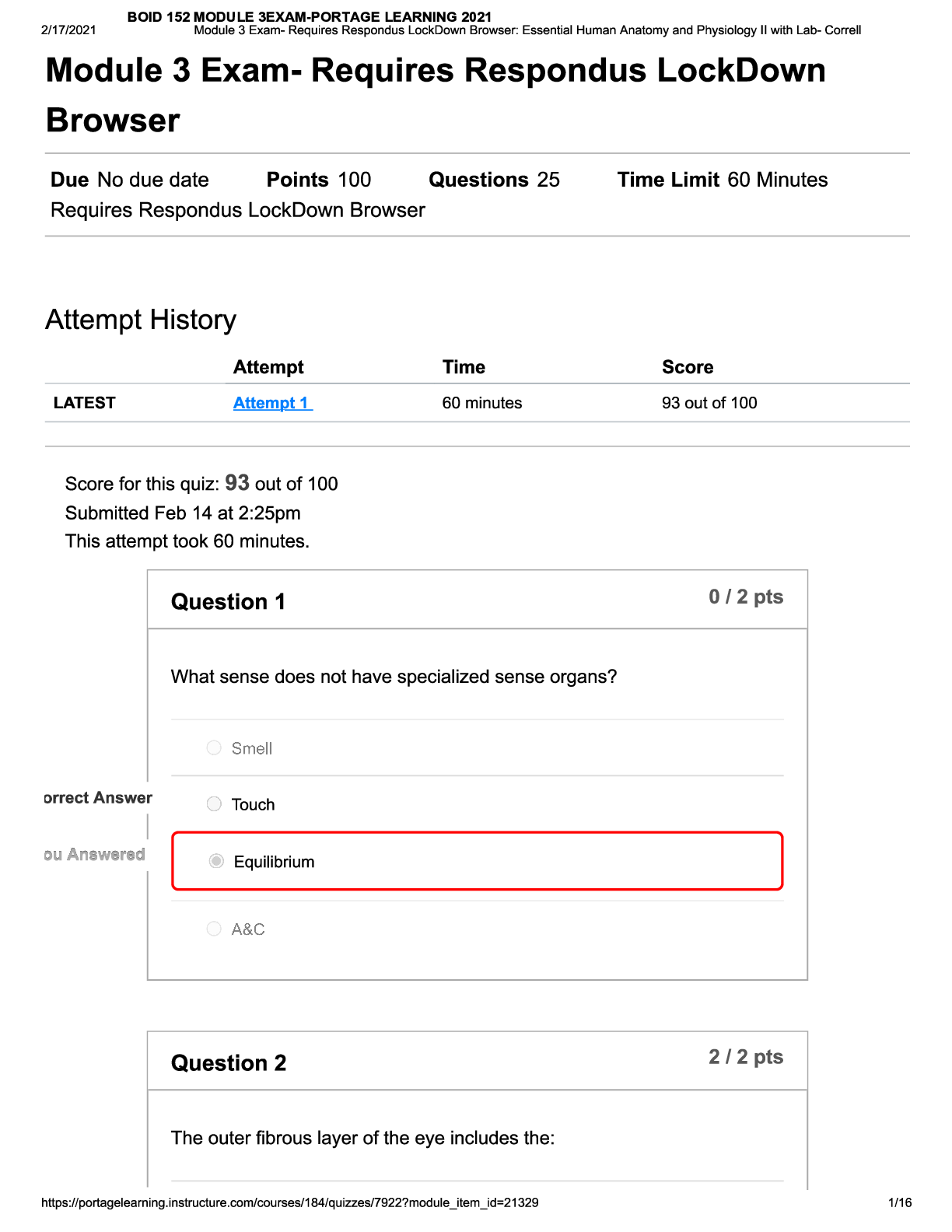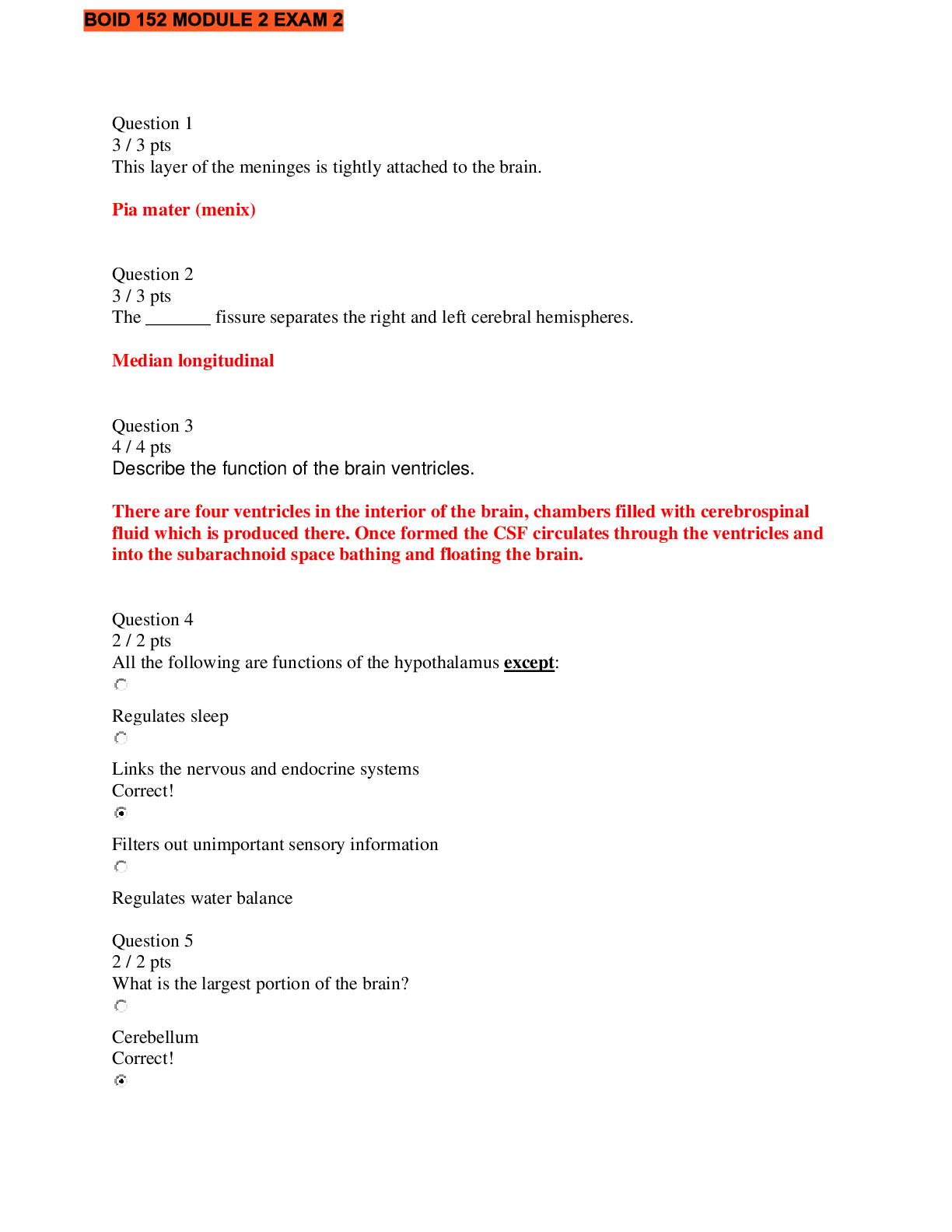Education > EXAM > Portage Learning BIOD 152 MODULE 7 ESSENTIAL HUMAN ANATOMY AND PHYSIOLOGY 11 (100% correct) (All)
Portage Learning BIOD 152 MODULE 7 ESSENTIAL HUMAN ANATOMY AND PHYSIOLOGY 11 (100% correct)
Document Content and Description Below
Exam 7 Question 1: True/False: The kidneys are long, thin muscular tubes. True False **CAN ALSO ASK: True or False: The bladder drains into the ureters. True False Question 2: A pers on sustained blun... t force trauma to the back at the T5 level, with no spinal cord injury. Would you suspect the kidneys to be damaged? Why or why not? No, the kidneys lie between the T-12 and L-3 Question 3: Describe the consistency and purpose of the renal capsule. The renal capsule is a tough fibrous outer skin of the kidney which protects it from injury and infection. Question 4: Name the layer and discuss the purpose of its extensions in the region highlighted in blue, below. Several extensions of the renal pelvis called calyces collect urine which drains continuously into the renal pelvis and subsequently into the ureter, which transports the urine to the bladder to be stored. **CAN ALSO ASK: Name the layer and the parts of the nephrons located in the region highlighted in green, below. Located within the cortex are the glomerular capsule and the distal and proximal convoluted tubule sections of the nephrons. Question 5: These arteries flow in between the renal pyramids. Afferent Lobar Interlobular Arcuate Interlobar Renal Question 6: Interlobular veins converge to form the . Efferent arterioles Lobar veins Interlobular veins Arcuate arteries Arcuate veins Peritubular capillaries **CAN ALSO ASK: After filtration occurs, next blood travels into these vessels. A. Efferent arteriole B. Lobar veins C. Interlobular veins D. Arcuate artery E. Interlobar vein F. Vasa recta Question 7: Name the region in the diagram below, indicated by the red arrow. PCT (Proximal convoluted tubule) **CAN ALSO ASK: Name the region in the diagram below, indicated by the red arrow. DCT (Distal convoluted tubule) Question 8: Which of the following is true about the location of the bladder? A. In males, the rectum is anterior to the bladder. B. In females, the vagina is behind the bladder. C. In females, the bladder sits above the uterus. D. In males, the bladder is below the prostate gland. E. B&C are true F. A&D are true **CAN ALSO ASK: Which of the following is false about the location of the bladder? A. In males, the bladder is anterior to the rectum. B. In females, the bladder is posterior to the uterus. C. In females, the bladder is in between the rectum and the uterus. D. In males, the bladder is above the prostate gland. E. B&C are false F. A&D are false Question 9: Describe the purposes of the urethral sphincters. ● The involuntary-controlled internal urethral sphincter is located near the bladder and keeps the urethra closed to prevent urine from leaving the bladder. ● The voluntary-controlled external urethral sphincter, composed of skeletal muscle, surrounds the urethra as it passes through the pelvic floor. Question 10: An elderly male with dementia frequently micturates at inappropriate times (during meals, not in the toilet). What is most likely causing the difficulty? Incontinence due to end stage dementia Incontinence due to swollen seminal vesicle Urinary retention due to not enjoying meals Urinary retention due to enlarged prostate Hematuria due to diabetes **CAN ALSO ASK: A patient was just placed under general anesthesia. He is now awake and telling you he is having a hard time excreting urine. What is most likely causing the difficulty? A. Incontinence due to stroke B. Incontinence due to dementia C. Urinary retention due to spinal cord injury D. Bladder outlet obstruction E. Urinary retention due to slowed detrusor muscle Question 11: This is the smallest region of the male urethra. Spongy Prostatic Membranous Ejaculatory duct Ureters **CAN ALSO ASK: This region of the male urethra exits the body. A. Spongy B. Prostatic C. Membranous D. Ejaculatory duct E. Ureters Question 12: Describe the difference between the two types of nephrons. - Cortical nephrons are in the cortex region of the kidney, except for a portion of their loop of Henle which extends into the medulla. - The remaining nephrons, called juxtamedullary nephrons, pass deeply into the medulla because of their location and their longer loops of Henle. **CAN ALSO ASK: What causes the extremely high blood pressure in the glomerular capillaries? The afferent arteriole, which is fed by the interlobular artery, is much larger in diameter than the efferent arteriole. The difference in diameter causes an extremely high blood pressure in the glomerular capillaries. Question 13: Micturition can be controlled consciously because of: Voluntary control over the internal sphincter Involuntary control over the internal sphincter Voluntary control over the external sphincter Involuntary control over the external sphincter Voluntary control over the visceral reflex arc None of the above: micturition cannot be voluntarily controlled Question 14: This is the blood pressure driving fluid out of the capillaries: Colloid osmotic pressure Capsular pressure Net filtration pressure Glomerular filtration rate Hydrostatic pressure **CAN ALSO ASK: This is the pressure that depends upon a person's blood pressure from the heart and vessels: A. Colloid osmotic pressure B. Capsular pressure C. Net filtration pressure D. Glomerular filtration rate E. Hydrostatic pressure Question 15: Calculate the net filtration pressure for your patient given the following values. Show your work. (Not all values listed may be used). - Colloid osmotic pressure = 25 - Capsular pressure= 15 - Hydrostatic pressure = 50 - GFR= 120 (Outgoing forces – incoming forces) HP- (COP + Capsular pressure) 50mmHg - (25mmHg +15mmHg)) = 10mmHg (net outward pressure) Question 16: Describe in detail how the kidney controls its own rate of blood flow through the nephron. This is called renal autoregulation because the kidney determines its own rate of blood flow by controlling the diameter of the afferent and efferent arterioles. By means of this autoregulatory system, the kidney can maintain a constant GFR despite variations in the arterial blood pressure in the rest of the body. **CAN ALSO ASK: Describe in detail what happens during an emergency to control the rate of blood to the kidney. During these times the renal autoregulatory system is superseded by higher level nervous system controls. When the nervous system takes over regulation, the afferent arterioles diameter is narrowed by sympathetic nerve fibers. The release of the hormone epinephrine by the adrenal medulla causes a decrease in renal blood flow and decreases the GFR. Constriction of the renal arteries is only to be used for a short time. Question 17: Which of the following statements is true concerning the RAA system? It responds when blood pressure becomes too high. Angiotensinogen is a pre-enzyme produced by the adrenal glands. Renin is released by the cells inside the nephron. Renin causes dilation of the afferent and efferent arterioles. Angiotensin I is converted to angiotensin II in the liver. **CAN ALSO ASK: Which of the following statements is false concerning the RAA system? A. Aldosterone causes the retention of sodium ions. B. It responds when blood pressure becomes too high. C. Angiotensin II acts to cause vasoconstriction in blood vessels. D. Renin is released by the cells inside the nephron. E. Renin converts angiotensinogen to angiotensin I. Question 18: The greatest amount of reabsorption occurs in the: Glomerular capsule DCT Descending loop Ascending loop PCT **CAN ALSO ASK: The greatest amount of occurs in the cells of the PCT. A. Reabsorption B. Excretion C. Secretion D. Countercurrent flow E. Osmolarity Question 19: True or False: Na+ can leave the ascending limb but not the descending limb. True False Question 20: Which of the following is false concerning ADH? It responds during excessive sweating conditions. When ADH is in circulation dilute urine is excreted. ADH acts by increasing channels in the collecting ducts. It inhibits urine output. **CAN ALSO ASK: Which of the following is true concerning ADH? A. It is produced by the adrenal glands. B. It is produced in response to increased water in the blood. C. It retains up to 99% of water in the filtrate. D. It is unable to respond during severe blood loss. Question 21: What is countercurrent flow? How does the nephron use this to maintain homeostasis? Countercurrent flow is the movement of fluids in opposite directions through adjacent channels. In the nephron, filtrate flows in one direction through the renal tubules while blood in the adjacent blood vessels flows in the opposite direction. Question 22: Describe the action of aldosterone on the concentrations of sodium and potassium in the filtrate. Sodium is pumped out of the filtrate to be returned to the blood while potassium (K+) is excreted in urine. **CAN ALSO ASK: Describe the action of aldosterone on the concentrations of sodium and hydrogen in the filtrate. Sodium is removed from the filtrate while hydrogen is pumped inside the filtrate. Question 23: Describe the action of caffeine on the nephron. Caffeine is a diuretic that causes the renal tubules to increase in diameter, increasing the amount of flow through the tubules. **CAN ALSO ASK: Describe the action of a drug that increases the rate of flow through the nephron. This would be a diuretic. When the filtrate moves at a faster rate through the nephron it allows less time for ions to be removed from the filtrate. Question 24: Which of the following is true concerning cardiovascular baroreceptors? They are mechanoreceptors found in the aortic arch and carotid sinus. They are in the lungs and the kidneys. These are chemoreceptors found in the hypothalamus. They are regulated by the hypoglossal and spinal accessory cranial nerves. Question 25: Yellow color in urine is due to the presence of: Pus Rhubarb Asparagus Urochrome Fruit **CAN ALSO ASK: Which of the following is an abnormal solute in urine? A. Urea B. Nitrogenous wastes C. Ammonia D. Magnesium E. Bile pigment Question 26: Water in the body is primarily found in what body compartment? Extracellular Intracellular Interstitial Plasma Synovial joints Question 27: Urine with a pH of 9.0 is: within normal range; acidic within normal range; alkaline outside normal range; acidic outside normal range; alkaline within normal range; neutral **CAN ALSO ASK: Urine with a pH of 5.0 is: A. within normal range; acidic B. within normal range; alkaline C. outside normal range; acidic D. outside normal range; alkaline E. within normal range; neutral Question 28: The bicarbonate buffer system: generally takes several days to respond. is the main buffer system of the urine. is the main buffer system of the interstitial fluid. causes hypoventilation in the respiratory system. all the above are true of the bicarbonate buffer system **CAN ALSO ASK: The protein buffer system: A. generally takes several hours to respond. B. causes hyperventilation in the respiratory system. C. is the main buffer system of the interstitial fluid. D. is the main buffer system of the intracellular fluid E. all the above are true of the protein buffer system Question 29: Hypoventilation is a part of what control mechanism? Explain what hypoventilation accomplishes. Respiratory control- If blood pH begins to rise (become more alkaline), the respiratory center is depressed, causing hypoventilation. During hypoventilation, the respiratory rate slows down, allowing more CO2 to accumulate, forming more hydrogen ions. The pH falls (becomes more acidic) and restores correct blood pH. (Optional) this reaction shifts to the right: CO2+ H2O ↔ H2CO3 ↔ H+ + HCO - **CAN ALSO ASK: A person is hyperventilating. This falls under what control mechanism? Explain what hyperventilation accomplishes. Respiratory control- Hyperventilation is an increase in the respiratory rate, helping to remove additional CO2. Within minutes increasing amounts of CO2is removed. Removing CO2 uses up H+ causes the pH to rise (becomes more alkaline) and restores correct blood pH. (Optional) this reaction shifts to the left: CO2+ H2O ↔ H2CO3 ↔ H+ + HCO3- Question 30: What control mechanism can remove acids and bases from the body? Renal control (Kidneys) Question 31: Your patient was just admitted to the hospital with renal failure. For the following questions, use the blood values of: pH =7.1, PCO2 = 30 mm, HCO3- = 20 mEq/L A. Determine if the patient is in acidosis or alkalosis. B. Is the cause respiratory or metabolic? C. Is the condition being compensated? D. If compensated, [Show More]
Last updated: 1 year ago
Preview 1 out of 16 pages
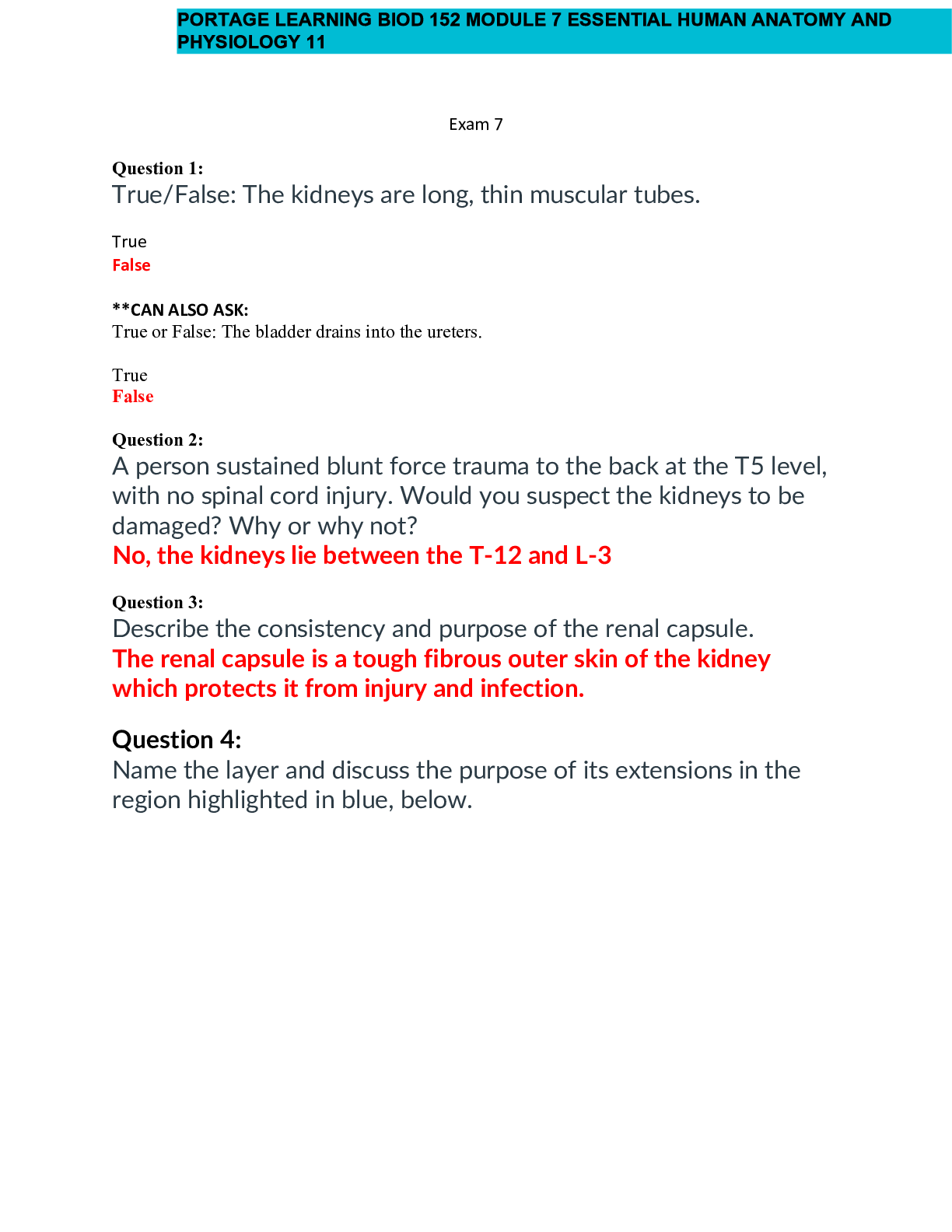
Reviews( 0 )
Document information
Connected school, study & course
About the document
Uploaded On
Jul 24, 2022
Number of pages
16
Written in
Additional information
This document has been written for:
Uploaded
Jul 24, 2022
Downloads
0
Views
41


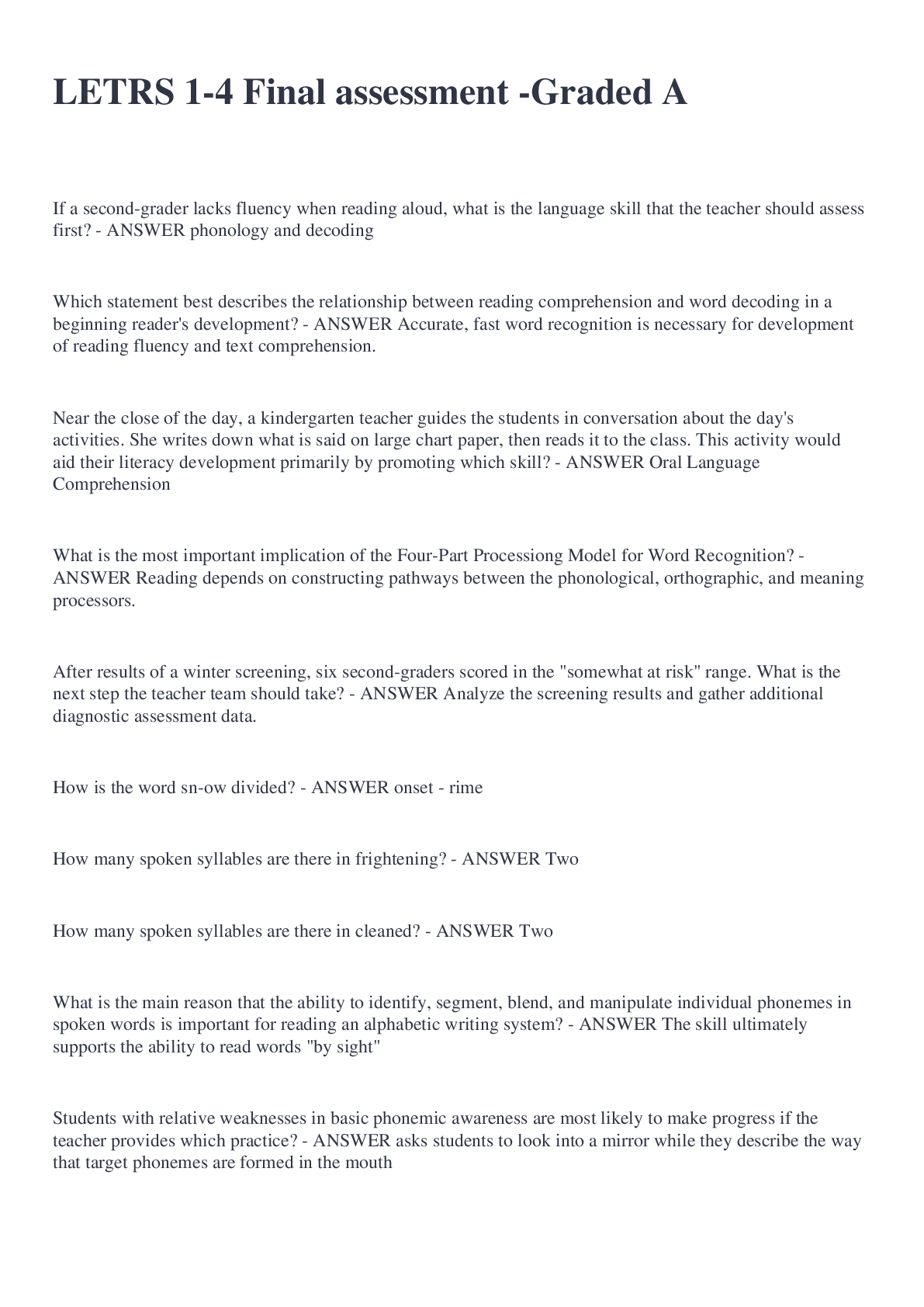


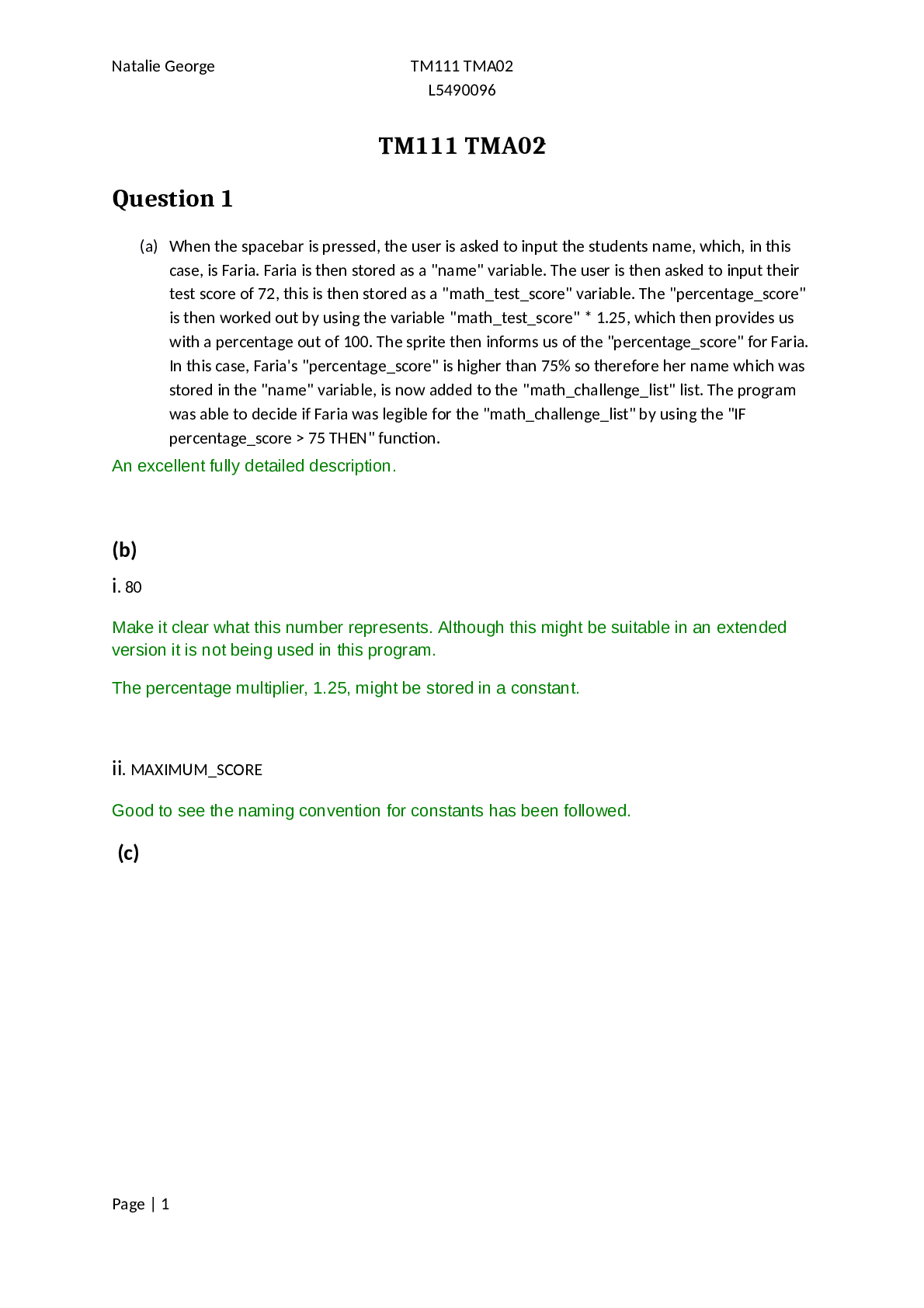


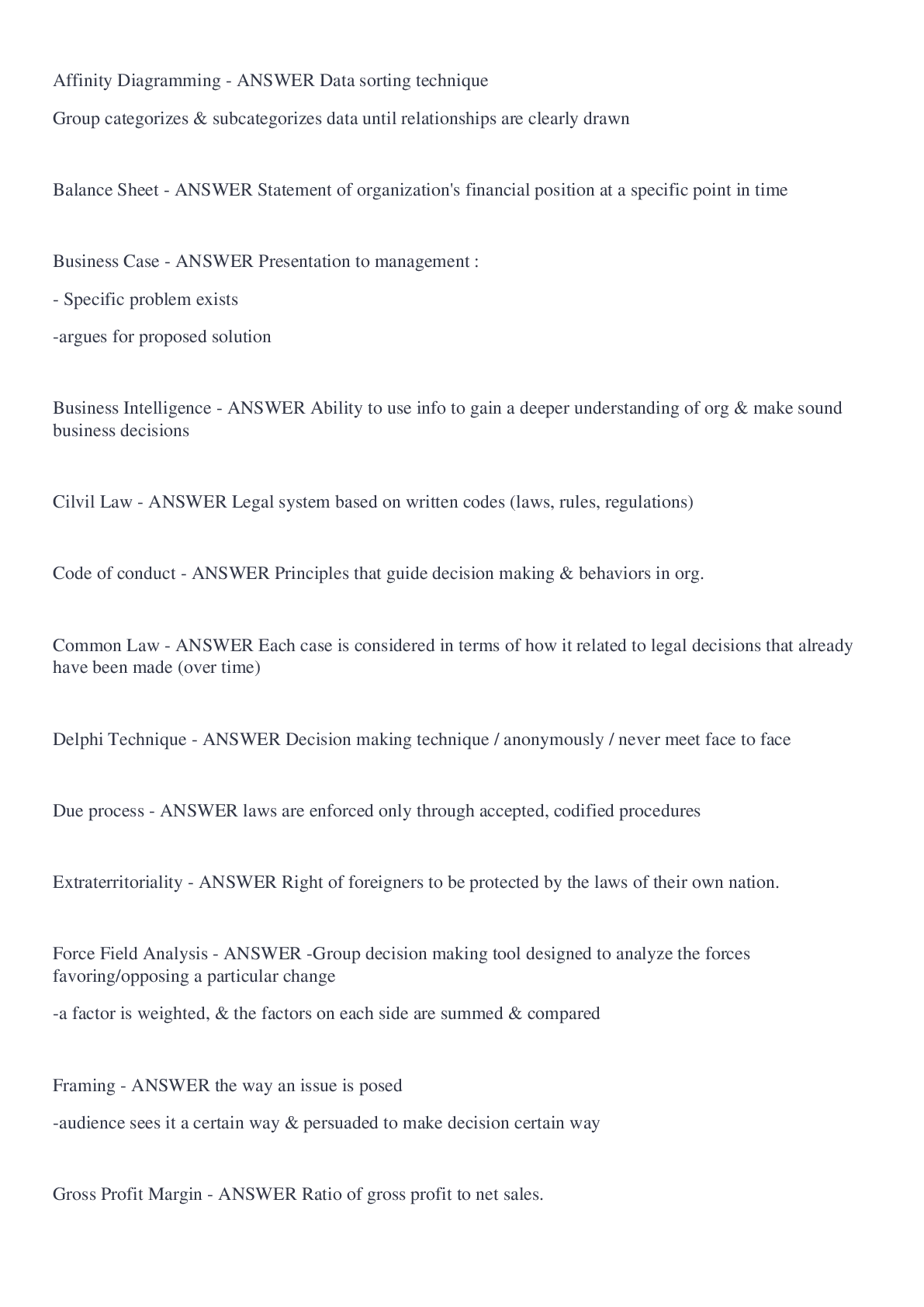

.png)
